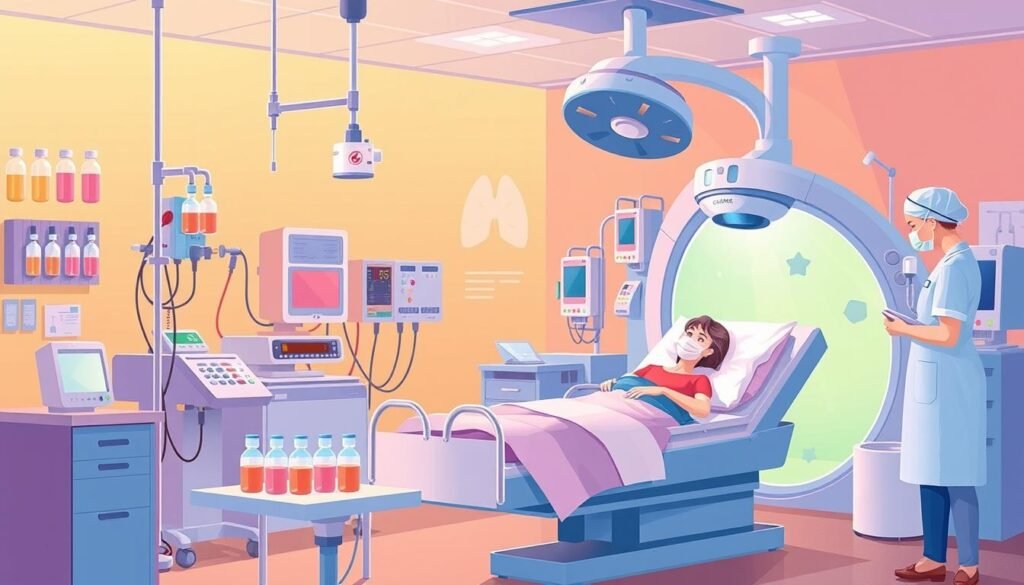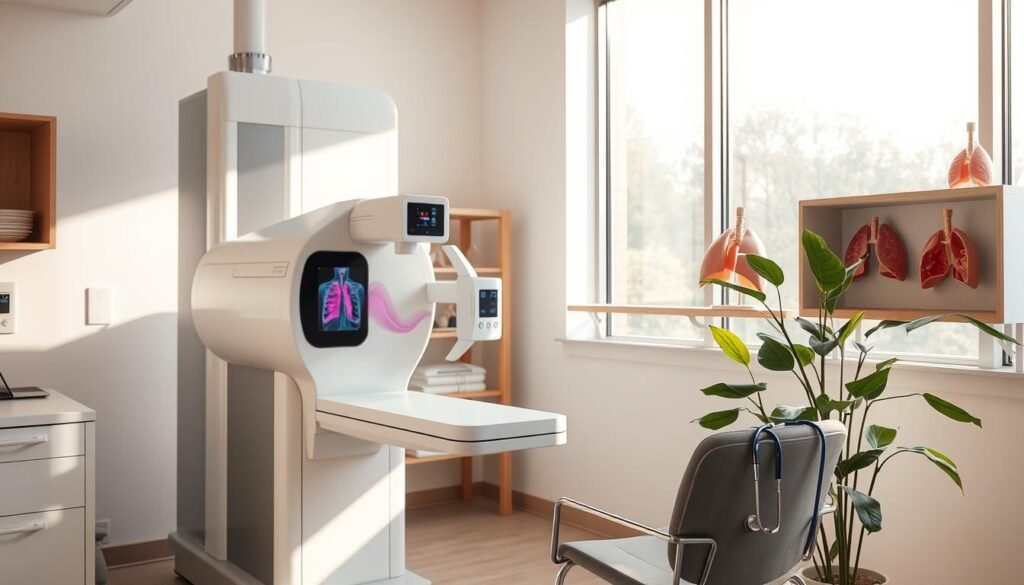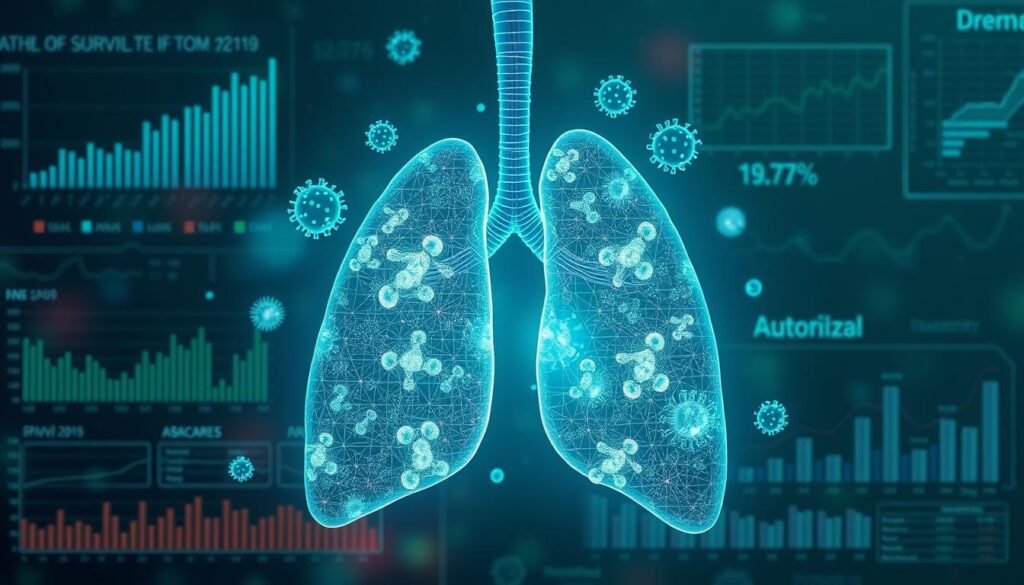Lung cancer gets diagnosed in the U.S. every two minutes. This fact stresses the need to know the lung cancer 5 year survival rate. Recently, stats show a 5-year survival rate of about 28.4%. This is a 26% improvement from five years ago. It brings hope, yet also shows the hard fight we still face. Every day, more than 361 lives are taken by lung cancer. Experts look at data from the SEER database. They see differences in survival rates based on the type and stage of cancer when found. This info is critical for understanding lung cancer prognosis.
Key Takeaways
- Lung cancer is diagnosed every two minutes in the U.S.
- The current 5-year survival rate for lung cancer is 28.4%.
- Over 361 lives are lost daily due to lung cancer.
- The 5-year relative survival rate has improved by 26% over the last five years.
- Screening with low-dose CT can reduce lung cancer mortality by 20%.
- Understanding survival statistics is crucial for informed treatment decisions.
Understanding Lung Cancer Survival Rates
Lung cancer is a major health issue. Knowing about lung cancer types and survival rates is vital for patient care. There are two main types: Non-Small Cell Lung Cancer (NSCLC) and Small Cell Lung Cancer (SCLC). NSCLC makes up about 80-85% of all cases, while SCLC is about 10-15%. Each type has different survival statistics.
Types of Lung Cancer and Their Survival Outcomes
Survival rates vary by lung cancer type. Here are some examples:
| Lung Cancer Type | Stage | 5-Year Survival Rate |
|---|---|---|
| Non-Small Cell Lung Cancer (NSCLC) | Localized | 65% |
| Small Cell Lung Cancer (SCLC) | Localized | 30% |
| NSCLC | Regional | 37% |
| SCLC | Regional | 18% |
| NSCLC | Distant | 9% |
| SCLC | Distant | 3% |
Early detection and treatment are key to better survival rates. They make a big difference in lung cancer outcomes.
What Is a Survival Rate?
A survival rate shows the percentage of people alive after a certain time following their cancer diagnosis, typically five years. It’s a key measure to understand survival. It also compares the life expectancy of cancer patients with the general population. For instance, a 60% 5-year relative survival rate means these patients have a 60% chance to survive as people without the disease.
Lung Cancer 5 Year Survival Rate
Lung cancer is a major health issue, with recent stats offering key insights. Now, the 5-year survival rate is at 26.7% for 2014 to 2020. This is a big increase from the 12.4% seen in the mid-1970s. Improvements in treatments and early detection efforts are crucial in these trends.
Current Statistics Compared to Historical Data
The survival rates for lung cancer have improved over time. Previously, survival rates were grim, with less than 20% living past five years after being diagnosed. But now, the data shows:
| Statistic | Current Rate | Historical Rate |
|---|---|---|
| Overall 5-Year Survival Rate | 26.7% (2014-2020) | 12.4% (mid-1970s) |
| Localized Lung Cancer (5-Year) | 63.7% | N/A |
| Regional Lung Cancer (5-Year) | 33% | N/A |
| Distant Lung Cancer (5-Year) | 6% | N/A |
This highlights how better recognition and treatments over time impact survival rates.
Impact of Early Detection on Survival Rates
Spotting lung cancer early drastically boosts survival rates. For local lung cancer, the 5-year survival rate can be as high as 65%. Yet, most lung cancers are found at Stage IV, drastically reducing survival chances.
Screening programs aim at high-risk groups, like long-term smokers. These efforts strive to catch cancer early, improving survival chances.
Lung Cancer Survival Statistics by Stage
The survival rates for lung cancer change a lot based on when it’s found. Knowing these numbers helps us understand how well treatments work at each stage. It highlights why finding the disease early is key for better results.
Localized Stage Survival Rates
When lung cancer is caught early, the chance of surviving is higher. For the most common type, the survival rate is around 65%. This shows that early treatment is effective. Methods like low-dose CT scans help catch it early, improving survival chances.
Regional Stage Survival Rates
As lung cancer spreads nearby, survival rates go down. For the common type, it drops to 37%. For a smaller group, it’s only 18%. This drop shows how crucial early finding and treatment are for survival.
Distant Stage Survival Rates
When cancer spreads far, the situation worsens. The survival rate for the common type goes down to about 9%. For the less common type, it’s even lower at 3%. This underlines the need for better research and early detection methods.
Spotting lung cancer early and treating it fast is key to better survival rates. Both doctors and patients must use the latest tests and treatments. To learn more about important lung cancer tests, check out this resource.
Factors Influencing Lung Cancer Prognosis
The outlook for lung cancer depends on many important factors. It’s key for patients and doctors to know these factors. They help in choosing treatments and predicting outcomes.
Age and Overall Health
Age and overall health are big factors in lung cancer outcomes. Younger patients generally do better. They have fewer other health problems that make treatment harder. Good overall health boosts your chances of a better outcome. Those in better shape tend to have a more positive outlook.
Subtypes of Lung Cancer
The type of lung cancer makes a big difference in survival chances. Non-small cell lung cancer (NSCLC) usually has a better outlook than small cell lung cancer (SCLC). For example, adenocarcinoma, a kind of NSCLC, has more hopeful survival rates than SCLC. Knowing the subtype helps doctors predict how well treatment might work.
Genetic Factors and Treatment Response
Genetic factors in lung cancer influence how well treatments work. Mutations in the cancer can guide doctors to more personalized treatments. Treatments aimed at specific genetic changes in the cancer are improving survival. This move towards customizing treatment based on genetics is changing lung cancer care.
Stage 4 Lung Cancer Survival Rate
Stage 4 lung cancer comes with big treatment challenges. It has often spread to other parts of the body. At this late stage, treatments mainly aim to extend life. Doctors and patients look at options like chemotherapy, immunotherapy, and targeted treatments. Still, how well these work can vary a lot.
Challenges in Treatment
Stage 4 lung cancer is tough to treat due to its spread and the patient’s health. Stage 4 non-small cell lung cancer shows different survival times based on the cancer’s progress. For example, patients in the M1c group tend to live about 6.3 months on average. Those in the M1a and M1b groups can live up to 11.4 months.
Statistics and Trends for Stage 4 Patients
The American Cancer Society states the 5-year survival rate for this cancer is only 9%. The one-year survival rate is between 15% and 19%. Age matters in these numbers. People under 50 have a 14.2% chance to live 5 years. This drops to 5.6% for those 65 and older. Men and women’s survival rates also differ; women have a 5.6% chance, and men have an 8.6% chance.
Survival rates are low but improving thanks to new treatments and research. For common NSCLC types in this stage, lung adenocarcinoma patients have a 20.6% chance to live 5 years. This is more than squamous cell carcinoma’s 17.6% and large cell carcinoma’s 13.2% survival rates.
| Statistic | Value |
|---|---|
| 5-Year Survival Rate (Overall) | 9% |
| One-Year Survival Rate | 15%-19% |
| 5-Year Survival Rate Under 50 | 14.2% |
| 5-Year Survival Rate Over 65 | 5.6% |
| 5-Year Survival Rate for Women | 5.6% |
| 5-Year Survival Rate for Men | 8.6% |
| Median Survival Time (M1c) | 6.3 months |
| Median Survival Time (M1a and M1b) | 11.4 months |
Best Treatments for Lung Cancer
Lung cancer has many treatments. It’s important to know about both traditional and new therapies. This knowledge helps patients get better outcomes.
Overview of Conventional Treatments
Surgery, chemotherapy, and radiation are common treatments. Surgery is usually the first choice for early lung cancer. It tries to remove the cancer completely. This gives patients the best chance to be cured.
Chemotherapy is key for advanced cancer. It can shrink tumors before surgery or help when surgery isn’t possible. Radiation is critical for those who can’t have surgery, especially with non-small cell lung cancer (NSCLC).
Emerging Therapies and Clinical Trials
New therapies for lung cancer are changing how we treat it. Targeted therapies and immunotherapies are becoming popular. They aim at specific changes in cancer cells, making treatment more personal.
Many clinical trials are testing these new options. For example, trials with nivolumab and ipilimumab are showing good results for certain patients. Using these new therapies along with current ones could lead to better survival rates for lung cancer patients.

Lung Cancer Survival Rates by Age
Lung cancer survival rates vary with age. Younger people often have better outcomes. Health and other diseases play a big role in these results. Older adults sometimes struggle with treatment, but there’s hope thanks to medical progress.
Trends in Survival Rates Across Age Groups
The survival rates for early-stage lung cancer show big differences by age:
| Age Group | Five-Year Survival Rate |
|---|---|
| Under 50 | 83.7% |
| Ages 50-64 | 67.4% |
| 65 and older | 54.6% |
This proves we need treatments suited for each age group. Younger folks often do better because they have fewer other health issues. Older adults might improve with tailored care.
The Importance of Age-Appropriate Treatment Strategies
Age-based treatment can make a huge difference. It helps doctors plan better, thinking about a person’s age and possible side effects. Young patients might handle strong treatments, while older ones may need something easier.
Learn more about lung cancer survival and treatments here. Personalized care is getting more attention, changing treatments to help patients more.
Improving Lung Cancer Survival Outcomes
There’s better news now for lung cancer survival. It’s key to catch it early. Lung cancer screening plays a big role here. It catches the disease early when it’s easier to treat. Doctors suggest yearly low-dose CT scans for those at high risk. These scans help catch the disease early, greatly improving survival chances.

Role of Early Screening and Diagnosis
Finding lung cancer early is critical. If caught early, there’s a 63% chance of surviving five years. But if found late, the survival rate drops to 8%. Unfortunately, only 4.5% of people who should get screened actually do. We need more people to take part in lung cancer screening programs. Today, 44% of lung cancer cases are found too late.
Advancements in Treatment Options
Treatment for lung cancer is getting better fast. We have new therapies that are really making a difference. These include targeted therapies and immunotherapy. They’re better than old treatments and are saving more lives. For example, those with adenocarcinoma are seeing benefits from these new treatments.
Because of early detection and these treatments, survival rates are going up. Research keeps improving these rates. For instance, from 2015 to 2019, the survival rate for lung cancer increased by 22%. This proves how important it is to approach lung cancer from all sides.
Getting diagnosed early and using new treatments can give patients hope. It leads to better survival rates and better life quality. Check out more about early diagnosis here.
Lung Cancer Research and Future Directions
Research on lung cancer is crucial for better treatments and survival rates. Current efforts focus on new ways to treat cancer. They look closely at personalized medicine and specific therapies for each patient’s cancer.
Current Studies and Trials
In the US, many clinical trials are testing new drugs and therapies. Immunotherapy is being explored as a way to fight lung cancer. These trials could lead to major advances in treating lung cancer, lending hope to many.
Potential Breakthroughs in Lung Cancer Treatment
There are exciting developments expected in lung cancer treatment. Research could change how we treat lung cancer soon. The Lung Ambition Alliance wants to double the five-year survival rate by 2025. Their work shows a united effort to make life better for patients. To learn more about lung cancer and survival rates, read this in-depth report here.
Impact of COVID-19 on Lung Cancer Survival Rates
The COVID-19 pandemic deeply affected healthcare, especially lung cancer care. Routine screenings and treatments were disrupted. This affected lung cancer patients’ prognoses badly. Many factors have caused these issues, which could hurt survival rates.
Disruptions in Care and Screening
At the start of the pandemic, lung cancer patients struggled to get care on time. Screenings for lung cancer dropped. This led to many being diagnosed at a later stage. COVID-19’s impact on lung cancer care was clear as early detection suffered.
Statistics on COVID’s Effect on Lung Cancer Patients
Recent stats offer a stark look at lung cancer patients during the pandemic. A study of 320 people showed those diagnosed during COVID-19 were more likely to have advanced-stage cancer. Also, the typical age of patients dropped, and many were in poorer health at diagnosis.

Adjusted death rates for lung cancer patients who caught COVID-19 were shockingly high at 52.3%. This is much higher than the 10.2% for others. This showcases how vulnerable lung cancer patients were during the pandemic. The link between COVID-19 statistics lung cancer and survival is clear.
The pandemic changed not just how we treat cancer now. It will also affect the future outcomes for those fighting lung cancer.
Understanding the Numbers
Looking at lung cancer survival stats, we need to know they have limits. These numbers give a broad view but don’t tell us everything. Things like new treatments, personal health, and the cancer’s nature matter a lot.
Limitations of Survival Statistics
While cancer statistics give a big picture, they’re not final truths about what will happen. For instance, the 5-year survival rate for early-stage non-small cell lung cancer is 65%. But it drops to 9% for advanced stages. These numbers leave out key details like cancer types, genetic factors, and overall health. So, it’s key for patients and families to talk about these limitations of survival statistics with their doctors.
Questions Patients Should Ask Their Doctors
If you have lung cancer, asking the right questions is vital. Questions help you understand your condition and what you can do about it. Here are some important questions for doctors lung cancer you might think about:
- What is my specific lung cancer type and stage?
- What are the latest treatment options available?
- How do my overall health and lifestyle choices impact my prognosis?
- What has been the success rate of the chosen treatments for my cancer type?
- What are the potential side effects or risks of these treatments?
Talking openly helps you make choices that are right for you. For more info on lung cancer stats and survival rates, the Surveillance, Epidemiology, and End Results (SEER) resource is very helpful.
Conclusion
Knowing about 5-year survival rates helps lung cancer patients and their families. It assists them as they deal with this tough disease. The survival rates for lung cancer can change a lot. This depends on the cancer stage, type, and treatment choices.
In Taiwan, survival rates have improved greatly. For those diagnosed in 2013, the rate was 23.8%. By 2020, it’s expected to reach 38.7%. This shows progress.
In the U.S., survival rates have gone up by 26% in five years. Now, it’s at 28.4%. This increase shows the benefits of early detection and better treatments. The Lung Ambition Alliance aims to double survival rates by 2025. This goal gives hope for the future.
It’s important for people at risk to get screened for lung cancer. Screenings have been proven to save lives and lower death rates. With new treatments being developed, there’s hope for those with lung cancer. Everyone working together gives us optimism for better outcomes ahead.